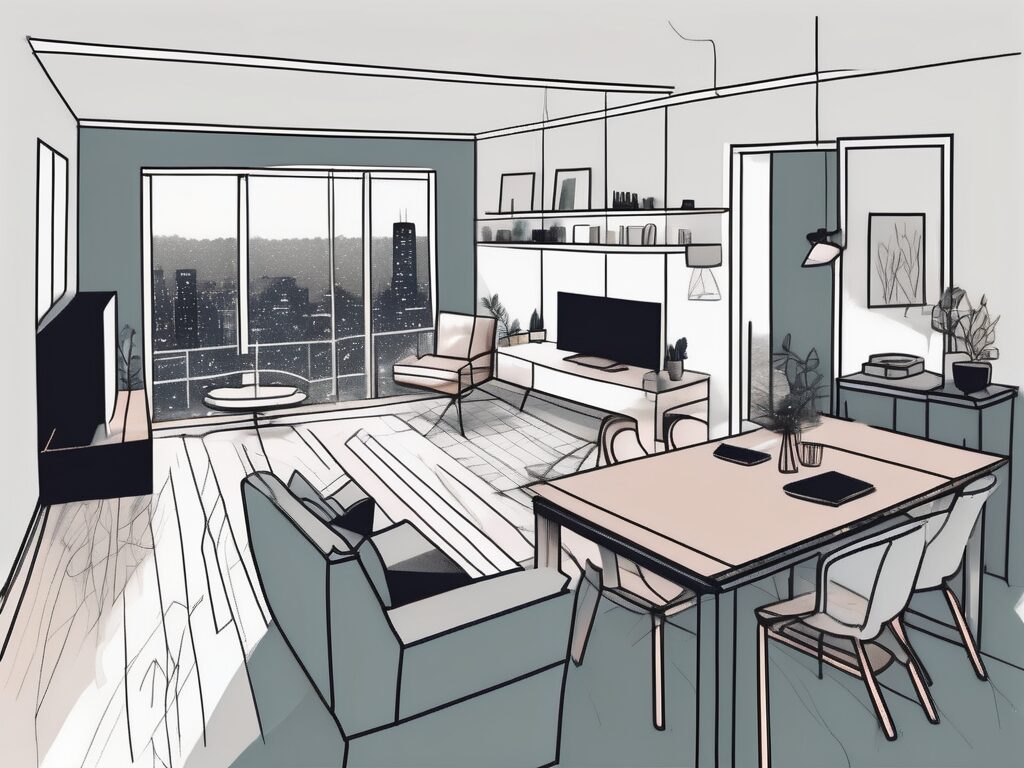
Agent A-Team or Solo Superhero? Finding the Right Real Estate Partner for Your Selling Journey in Wildwood Florida
When it comes to selling your home in Wildwood, Florida,…
January 29, 2024
In recent years, open concept floor plans have become increasingly popular in home design. The appeal of these spacious and interconnected living spaces is undeniable, with their promise of enhancing natural light, airflow, and social interactions. However, as with any trend, there are potential downsides that are causing a shift away from this once-beloved concept. In this article, we will explore the benefits of open layouts, uncover the origins of the open concept craze, delve into the resurgence of walls, discuss finding the balance between openness and privacy, and finally, debunk the open concept myth by examining its future in home design.
Open concept floor plans have long been praised for their ability to enhance natural light and airflow within a home. By removing walls and barriers, sunlight is able to illuminate the entire space, creating a bright and welcoming atmosphere. Additionally, the uninterrupted flow of air throughout the open space allows for better ventilation, which can improve the overall air quality in the home.
But the benefits of open layouts extend beyond just practicality. There is something inherently inviting and comforting about a space that is open and free-flowing. It creates a sense of expansiveness and freedom, making the home feel larger and more spacious than it actually is. This can be especially beneficial for smaller homes or apartments, where every inch of space counts.
Furthermore, open layouts offer social advantages that cannot be overlooked. They promote a sense of togetherness and make it easier for families and friends to gather and interact. Whether it’s hosting a dinner party or simply having a casual conversation while preparing a meal, open concept living allows for easy communication and connection.
Imagine a family gathering where everyone can be in the same space, yet still engage in different activities. The kids can be playing board games at the dining table, while the parents are cooking in the kitchen, and the grandparents are relaxing on the sofa, all within sight and earshot of each other. This kind of open living fosters a sense of unity and closeness, creating lasting memories and strengthening relationships.
Additionally, open layouts can be highly adaptable and versatile. With fewer walls and partitions, it becomes easier to rearrange furniture and change the layout of the space to suit different needs and preferences. This flexibility allows homeowners to easily transform their living areas for various occasions, whether it’s setting up a home office, creating a play area for children, or even hosting a yoga session with friends.
Moreover, the open nature of these layouts encourages creativity and personal expression. Without the constraints of walls and separate rooms, homeowners have the freedom to design and decorate their spaces in unique and innovative ways. They can experiment with different furniture arrangements, play with color schemes, and showcase their personal style throughout the entire living area.
Open layouts also have the added benefit of being more conducive to entertaining guests. Whether it’s a small gathering or a large party, an open space allows for better flow and movement, ensuring that guests can easily navigate and mingle. It creates a welcoming and inclusive atmosphere, where everyone feels connected and involved.
In conclusion, open layouts offer a multitude of benefits that go beyond just enhancing natural light and airflow. They create a sense of spaciousness, promote social interaction, and provide flexibility for various activities and occasions. So, if you’re considering a home renovation or looking for a new place to live, don’t overlook the advantages of an open concept floor plan. It may just be the key to creating a vibrant and inviting living space.
The rise in popularity of open concept floor plans can be traced back to a shift in home design trends. Traditionally, homes were designed with divided spaces, with each room serving a specific purpose. However, as our lifestyles and preferences changed, homeowners began seeking more open and flexible spaces that allowed for multitasking and a seamless flow between activities.
This shift was further fueled by television shows that showcased open concept living as a desirable and modern way of living. Viewers were captivated by the way spaces seamlessly merged together, creating the illusion of a larger and more welcoming home.
One of the key factors that contributed to the open concept craze was the increasing desire for social interaction and connectivity within the home. As people became more aware of the importance of spending quality time with family and friends, the need for spaces that facilitated interaction became paramount.
Open concept floor plans provided the perfect solution. By removing walls and barriers, these designs allowed for easy communication and interaction between family members, even when they were engaged in different activities. Parents could keep an eye on their children while cooking in the kitchen, and conversations could flow freely from one area to another.
Another reason behind the popularity of open concept living was the desire for a more spacious and airy feel. Traditional homes with their compartmentalized rooms often felt cramped and closed off. With open concept designs, the removal of walls created a sense of expansiveness and freedom.
Furthermore, open concept living catered to the modern lifestyle, which emphasized multitasking and flexibility. In a fast-paced world where work, leisure, and family life often overlapped, homeowners sought spaces that could easily adapt to their changing needs. Open concept floor plans allowed for seamless transitions between different activities, making it easier to juggle work, play, and relaxation within the same space.
Television shows played a significant role in popularizing open concept living. Home improvement and interior design programs showcased stunning transformations where walls were torn down, revealing beautiful open spaces that were both functional and aesthetically pleasing. These shows not only inspired viewers but also provided them with practical ideas and tips on how to achieve the open concept look in their own homes.
As the open concept trend gained momentum, architects and designers began incorporating it into new construction projects. The demand for open concept floor plans grew, and soon it became a standard feature in many newly built homes. Real estate developers recognized the appeal of open concept living and marketed it as a desirable selling point, further fueling its popularity.
In conclusion, the origins of the open concept craze can be attributed to a combination of changing lifestyles, the desire for social connectivity, the need for more spacious and flexible living spaces, and the influence of television shows. As homeowners continue to prioritize open concept living, it is likely that this trend will continue to evolve and shape the future of home design.
While open concept floor plans dominated the home design scene for many years, there is now a noticeable resurgence of walls and defined spaces. People are beginning to realize that while openness and connectivity are important, there is also a need for privacy and separation.
A growing trend in home design is the return of defined spaces. Homeowners are seeking out separate rooms that can be used for specific activities, such as a dedicated home office or a cozy reading nook. These defined spaces allow for focused work, relaxation, and solitude, providing a sense of tranquility in an otherwise bustling household.
One of the reasons behind the resurgence of walls is the desire for privacy. In an open concept floor plan, it can be challenging to find a quiet space to concentrate or have a private conversation. By incorporating walls into the design, homeowners can create designated areas where they can retreat and have some alone time.
Additionally, walls offer a sense of structure and definition to a space. They provide a clear separation between different areas of the home, making it easier to organize and decorate each room according to its specific purpose. With walls, homeowners can create distinct living spaces that cater to their individual needs and preferences.
Another factor contributing to the return of walls is the desire for sound insulation. Open concept floor plans, while visually appealing, can often result in noise traveling freely throughout the space. By reintroducing walls, homeowners can minimize noise pollution and create a more peaceful and serene environment.
Furthermore, walls offer an opportunity for creativity and personalization. With the resurgence of walls, homeowners can experiment with various design elements, such as accent walls, textured wallpapers, or unique paint colors. These design choices can add depth and character to a room, making it a true reflection of the homeowner’s style and personality.
In conclusion, the resurgence of walls in home design represents a shift in trends towards a more balanced approach to living spaces. While open concept floor plans will always have their appeal, the inclusion of walls allows for privacy, structure, sound insulation, and creative expression. Whether it’s creating a dedicated workspace or a cozy reading nook, the return of defined spaces brings a sense of tranquility and individuality to modern homes.
Creating a home that strikes the perfect balance between openness and privacy requires careful consideration and planning. Designers are embracing the challenge of incorporating elements of both open and defined spaces into their designs, creating homes that offer the best of both worlds.
Functionality plays a key role in achieving this balance. Designing spaces that serve multiple purposes allows homeowners to enjoy the benefits of open concept living while still maintaining the option for privacy and seclusion when desired. For example, sliding doors or room dividers can be used to separate spaces when needed, providing flexibility in the layout.
When it comes to open concept living, one of the main advantages is the sense of spaciousness it creates. By removing walls and barriers, natural light is able to flow freely throughout the space, making it feel larger and more inviting. This open and airy atmosphere can greatly enhance the overall aesthetic of a home, creating a welcoming environment for both residents and guests.
However, while open concept living is undoubtedly appealing, it can also present challenges when it comes to privacy. There are times when we all crave a little solitude, whether it’s to work, relax, or simply have some quiet time. This is where the importance of defined spaces comes into play.
By incorporating elements such as sliding doors or room dividers, homeowners can easily transform an open space into a more private area. This allows for greater flexibility in how the space is used, catering to the needs and preferences of the individuals living in the home. Whether it’s creating a separate home office, a cozy reading nook, or a secluded area for relaxation, these defined spaces offer a retreat from the hustle and bustle of everyday life.
Another way to achieve the balance between openness and privacy is through the use of furniture and decor. Strategic placement of furniture can help create visual boundaries within an open space, giving the illusion of separate areas. For example, a large bookshelf or a freestanding screen can be used to divide a living room into distinct zones, without completely closing off the space.
Furthermore, the choice of materials and finishes can also contribute to the overall sense of privacy within an open concept home. Opting for opaque or frosted glass instead of clear glass for windows and doors can provide a level of privacy while still allowing natural light to filter through. Additionally, using sound-absorbing materials such as curtains, rugs, and upholstered furniture can help minimize noise and create a more intimate atmosphere.
Ultimately, finding the balance between openness and privacy is a personal journey that varies from homeowner to homeowner. It’s about creating spaces that reflect individual lifestyles and preferences, while still maintaining a harmonious flow throughout the home. By carefully considering the layout, functionality, and design elements, designers can create homes that seamlessly blend openness and privacy, offering a truly unique and satisfying living experience.
Despite the recent shift towards defined spaces, it is important to note that open concept floor plans are not going away entirely. They still have their merits and continue to be favored by many homeowners. However, there is a growing recognition that open layouts are not a one-size-fits-all solution and that the downsides must be considered.
One of the main advantages of open concept living is the sense of spaciousness it provides. By removing walls and barriers, natural light is able to flow freely throughout the space, creating an airy and bright atmosphere. This can make a home feel larger and more inviting, especially in smaller or older houses where traditional compartmentalized layouts can feel cramped and dark.
Additionally, open concept floor plans promote social interaction and connectivity. They allow for easy communication and interaction between family members or guests, making it ideal for entertaining or keeping an eye on children while preparing meals. The absence of walls also encourages a sense of togetherness and fosters a more communal living experience.
However, it is important to acknowledge that open concept living is not without its drawbacks. One of the main concerns is the lack of privacy. With fewer walls and barriers, it can be challenging to find a quiet space for focused work or relaxation. This can be particularly problematic in households with multiple occupants or when hosting guests overnight.
Another potential downside of open concept floor plans is the difficulty in defining functional zones. Without walls to separate different areas, it can be challenging to create distinct spaces for specific activities. This can lead to a lack of storage options and a cluttered appearance, as there are no walls to hide away everyday items or create designated storage areas.
As the home design industry evolves, we can expect to see a more thoughtful approach to open concept living. Designers and homeowners alike will continue to experiment with ways to create spaces that provide both openness and privacy, striking a delicate balance that caters to individual needs and preferences.
One possible solution to address the privacy issue is the incorporation of sliding or pocket doors. These can be used to separate spaces when needed, providing the option to create private areas while still maintaining the open feel when desired. Another approach is the use of furniture and room dividers to create visual separation and define functional zones within the open space.
Furthermore, advancements in technology may also play a role in enhancing open concept living. Smart home systems can offer innovative solutions to privacy concerns, such as soundproofing materials or adjustable privacy screens that can be controlled with a simple voice command or through a smartphone app.
Ultimately, the future of open concept living lies in finding the right balance between openness and privacy. While it may not be the perfect fit for everyone, with careful consideration and creative design solutions, open concept floor plans can continue to be a popular choice for homeowners who value a sense of spaciousness and connectivity in their living spaces.
Looking ahead, open concept floor plans are likely to undergo further refinements. The trend may shift towards creating semi-open spaces, where there are designated areas for specific activities but still maintain a sense of connectivity.
Additionally, advancements in technology and interior design will play a role in shaping the future of open concept living. Smart home systems that allow for customizable layouts and adaptable spaces will become more prevalent, giving homeowners the freedom to customize their living environments to suit their ever-changing needs.
In conclusion, while open concept floor plans have enjoyed immense popularity in recent years, there is a growing recognition of their downsides. The shift away from complete openness towards defined spaces and privacy highlights the importance of finding a balance in home design. As the industry moves forward, it will be fascinating to see how open concept living continues to evolve and adapt to meet the changing needs and desires of homeowners.

If you want the Richr team to help you save thousands on your home just book a call.
 Book a call
Book a call